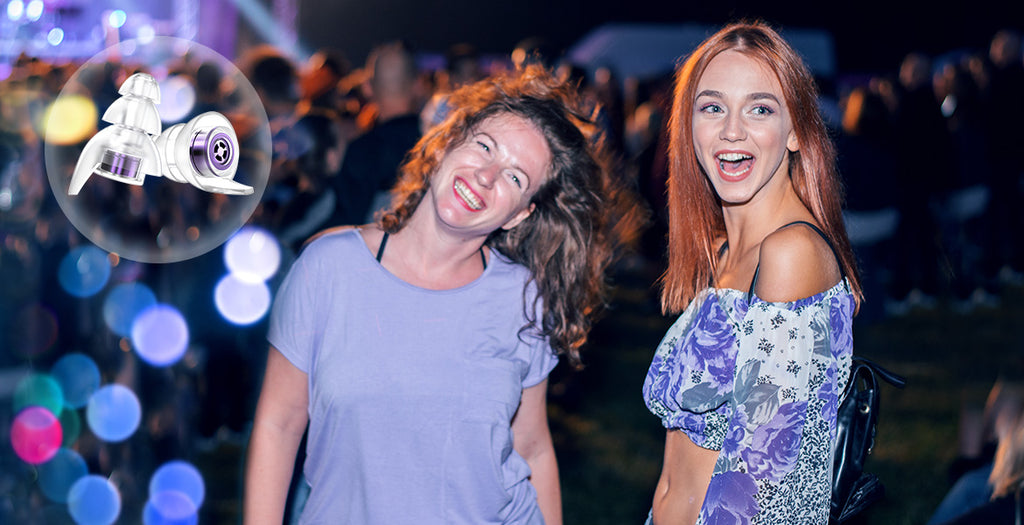Small foam or silicone earplugs have become a ubiquitous sight in modern life. You'll find them popped into people's ears at concerts, clubs, construction sites, factories, and many everyday settings. But why have these inconspicuous little sound-blocking devices become so pervasive?
This in-depth article explores the diverse array of reasons people wear earplugs today and delves into the many benefits they provide in our noise-filled world.
Preventing Irreversible Hearing Loss in High Decibel Environments

The #1 reason for the proliferation of earplug use is hearing health. Prolonged exposure to noise over 85 decibels can permanently destroy the tiny hair cells in your ears that allow you to hear. These cells don't regenerate, so noise-induced hearing damage is irreversible and cumulative over your lifetime. Unfortunately, many common settings like concerts, clubs, motorsports, airshows, and more now regularly exceed safe audio levels, sometimes hitting 120 decibels or higher.
That's as loud as a thunderclap or chainsaw, just inches from your ear. Even less extreme volumes can be hazardous over time; just 30 minutes at 100 decibels can result in permanent damage. At noisy venues, audio engineers and musicians are especially at high risk, as they endure repeated exposure during long events, rehearsals, and tours. Even patrons are unsafe without protection.
Luckily, wearing proper earplugs reduces decibel levels to safer ranges. Foam plugs provide 15–30 decibels of attenuation, while more advanced plugs can lower volumes up to 35 decibels. This prevents both instant acute trauma and gradual hearing deterioration over time. For anyone frequently in high-noise environments like construction, landscaping, manufacturing, cheering sports fans, and more, earplugs are essential tools for preserving long-term hearing health and quality of life.
Getting Better Sleep by Blocking Out Disruptive Noises
Promoting better sleep is another prime reason that earplugs have gained popularity. Many people dwell in noisy urban apartments or neighborhoods brimming with sleep-disrupting sounds: traffic, sirens, music, rowdy people, early garbage trucks, dogs, etc. Even suburban areas aren't immune from noisy distractions like nearby highways, loud neighbors, home electronics and alarms, or snoring partners.
By actively filtering out external noise, earplugs facilitate falling asleep faster, staying asleep through the night, and avoiding disruptive awakenings. Getting sufficient, uninterrupted, high-quality sleep is crucial for mental sharpness, memory, productivity, emotional regulation, immune health, heart health, and much more. Skimping on sleep is devastating for nearly every aspect of life.
For those facing regular sleep disruptions, trying a simple pair of foam earplugs can provide a startling transformation-turning restless, unsatisfying nights into deep, rejuvenating slumber. Silicone and wax earplugs are also popular sleep aids thanks to their moldable comfort. In our 24/7 world, quality shuteye requires blocking out intrusive sounds.
Boosting Work and Study Concentration
Another common application of earplugs is boosting mental focus in noisy, distracting environments. College students in dorms regularly use earplugs for uninterrupted study time in loud public campus areas. Libraries and test proctors often recommend them to enhance concentration and performance on exams.
Many workplaces are plagued by disruptive chatter, phone calls, office machinery, and irrelevant noises, detrimentally impacting employees' focus and productivity. By providing external sound attenuation, earplugs enable people to isolate mentally and fully devote their attention to cognitively demanding tasks requiring sustained focus.
Getting into a state of flow where you "tune out" surrounding stimuli is extremely difficult without first muting background noise. When learning complex new material or working through mentally taxing assignments, earplugs are a simple tool to amplify focus and retention. Knowledge workers, programmers, attorneys, architects, academics, and creators of all types rely on earplugs to achieve optimal cognitive function and productivity in noisy environments.
Critical Protective Equipment in Many Occupations
For those working in loud industrial, construction, landscaping, manufacturing, entertainment, airports, and other vocational settings, earplugs are mandatory daily protective equipment. Jackhammers, chainsaws, heavy machinery, power tools, truck engines, amplifiers, and other equipment easily exceed 100 decibels for extended periods, making progressive hearing damage inevitable over months and years of exposure.
Thus, workplace safety regulations strictly require earplug use once noise passes certain time and volume limits. More advanced filtered musician's earplugs allow production techs to communicate and move while protecting their hearing during concerts and shows. Custom-molded plugs keep field workers comfortable and protected through long shifts in extreme noise.
Failure to provide and enforce proper earplug use leaves employers legally liable for permanent employee hearing loss, an irreversible disability. Treat hearing protection as equally vital as hard hats, safety goggles, gloves, and fall protection. Prioritize both current worker safety and their ability to hear family, nature, and enjoy retirement.
Controlling Noise Intake for Custom Comfort
Beyond just preventing occupational and recreational hearing loss, people also wear earplugs for comfort and to customize noise levels to their personal preferences. Some use earplugs at movie theaters if the explosive surround sound effects are uncomfortably loud. Music lovers may pop them in at over-amplified concerts to enjoy shows without pain or damage.
Motorsports fans rely on earplugs to appreciate races without deafening engines exceeding safe volumes. Parents utilize child-sized earplugs to protect infants' and toddlers' developing hearing at loud events or during screaming fits. Those with noise sensitivity, autism, PTSD, migraine disorders, and other conditions often need earplugs to function comfortably in noisy environments. Just as sunglasses filter light, earplugs provide personalized sound filtering and volume control.
For many, earplugs are essential accessories, allowing them to partake in noisy activities they'd otherwise have to avoid. Being able to adjust sound intake provides confidence and autonomy.
Proper Insertion for Maximizing Protection

To obtain the full sound protection and comfort benefits of earplugs, proper insertion is key. Foam plugs must be compressed and rolled into narrow cylinders so they can expand deeply into the ear canal for a complete seal. Silicone and molded plugs should be inserted gently, with any attached cords positioned facing the rear.
Test different sizes and shapes to find the best-personalized fit for your ear anatomy. Listen for any airflow gaps by cupping your hands over plugged ears; a snug seal is quiet. Loose-fitting plugs allow damaging sound leakage. Take the time to ensure earplugs are fitting snugly and sitting deeply enough into the ear canals. With proper insertion, earplugs can reduce noise by 15–30 decibels, making loud volumes safer and disruptive sounds quieter.
Conclusion

From helping prevent permanent occupational and recreational hearing loss to aiding sleep, focus, and comfort, the recent surge in earplug use highlights their great value in modern life. As more people recognize their benefits, these inconspicuous little devices will only become more ubiquitous. Safe hearing, concentration, relaxation, and comfort are priceless.
So whether you're hitting up a loud concert or just trying to quietly sleep through the night, don't forget your trusty earplugs. For both your hearing health and sanity, keeping a pair handy is one of the wisest investments you can make.












